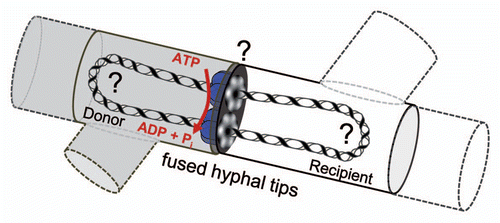Figures & data
Figure 1 Model of conjugative DNA translocation in mycelial streptomycetes. After establishing contact between donor (gray) and recipient mycelium (white, dashed lines indicate neighboring mycelial compartments) and partial fusion of the hyphal tips, TraB hexamers (blue) assemble at clt by specifically recognizing 8-bp TRS repeats. The TraB hexamers form pore structures to the recipient and direct the translocation of a double-stranded plasmid molecule. DNA transfer is energized by ATP hydrolysis. Up to now it is unclear (?) whether the circular plasmid DNA has to be processed into a linear molecule and which enzymes might be involved. For further description see text.

Table 1 PAT SCAN analysisTable Footnote* of the S. coelicolor genome for the presence of cltpSVH1-like chromosomal sequences (clc)Table Footnote*